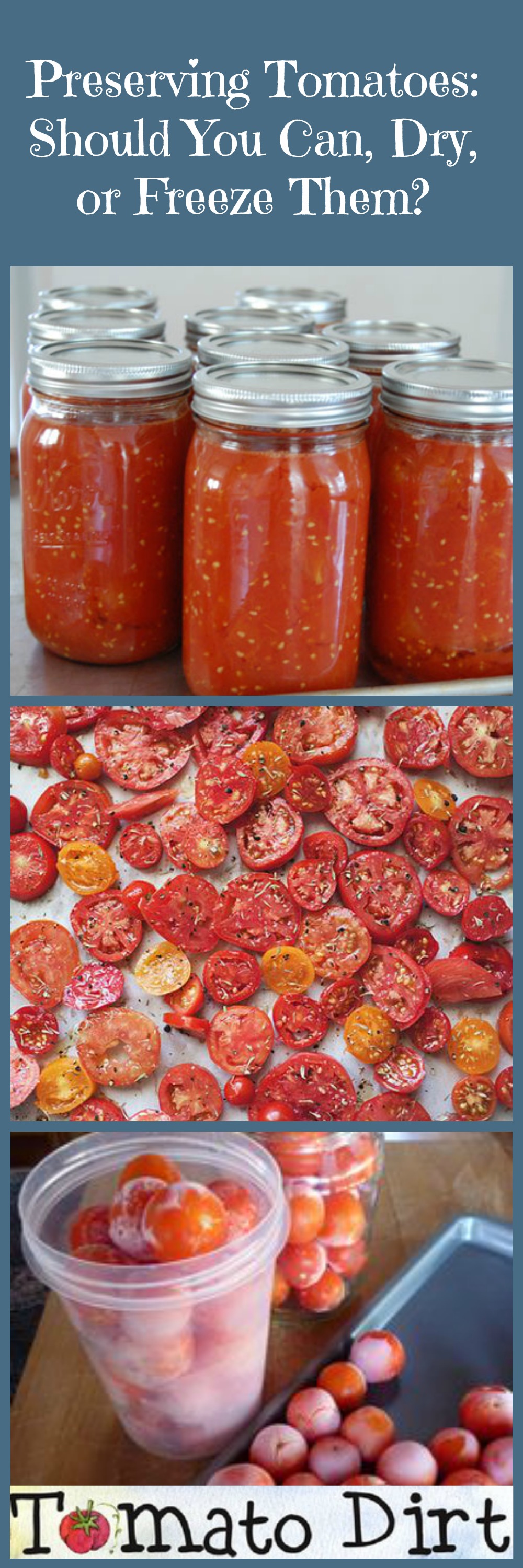FREE: 10 Must-Know Tomato Growing Tips Get The Guide
Read our affiliate disclosure here.
Preserving Tomatoes: Should I Can, Dry, or Freeze Them?
Since 2010, Tomato Dirt has garnered 4.8+ million views, making it the web’s leading online source for growing tomatoes in the home garden. Award-winning writer and Tomato Dirt owner Kathy Widenhouse has helped thousands of home gardeners grow healthier tomatoes. Be one of them when you get Tomato Dirt’s Growing Guide here.
Updated 8.5.24
Nothing can take the place of a fresh tomato.
But when it comes to preserving tomatoes, which is the best method: canning tomatoes, drying tomatoes, or freezing tomatoes?
The answer is … all three.
Each method for preserving tomatoes has benefits and drawbacks.
Here’s the dirt on each one so you can decide what to do with the extras in your tomato crop.
(And let us know your preference by posting your comment below.)
Canning Tomatoes
Benefits to Canning Tomatoes
Taste. Aficionados argue that you can preserve more fresh tomato flavor with canned tomatoes.
Volume. Canning is an especially useful route for preserving tomatoes when you have large quantities to process at one time – like when your determinate tomato crop comes in.
Versatility. Home canned tomatoes have a texture similar to commercially-produced canned tomatoes and are often eaten directly as a side dish, rather than being used solely for cooking. They also work well in casseroles, soups, stews, and sauces.
Safety. Tomatoes are one of the easiest types of produce to can safely.
Longevity. You won’t lose canned tomatoes in a power outage as you might with frozen tomatoes when a freezer’s power is cut off.
Space. Canned tomatoes save on precious freezer space.
Drawbacks to Canning Tomatoes
Time. By far, this method takes the longest in terms of hands-on work. (Drying tomatoes takes longer in a food dehydrator, but you can leave the dehydrator alone as it works its magic.)
Gear. Canning requires special equipment including a hot water bath canner or a pressure canner, canning jars, and lids. However, you can use the canner for preserving other vegetables, fruits, and even meats. And you can use canning jars again year after year.
Discomfort. You may heat up your kitchen when canning which can be especially uncomfortable in the summer months.
Drying Tomatoes
Benefits to Drying Tomatoes
Space. Dried tomatoes take less storage space than other preserved tomatoes.
Uniqueness. Dried tomatoes are expensive in stores but cheap to process at home. They add a gourmet touch to dishes
Simplicity. Dried tomatoes take no special equipment to produce if you dry them in the sunlight or in the microwave. (If you use the preferred method, a food dehydrator, you need to purchase one.)
Drawbacks to Drying Tomatoes
Cost. If you choose to dry tomatoes in a dehydrator, you must purchase one. However, you can use for year after year and you can use it to preserve other fruits and vegetables, too.
Time. Using a dehydrator can burn up t 8-12 hours per batch. It takes longer to dry tomatoes than to freeze or can them.
Limited Usability. Dried tomatoes are used in fewer recipes than canned or frozen tomatoes. In addition, they need to be reconstituted before using.
Freezing Tomatoes
Benefits to Freezing Tomatoes
Convenience. The easiest method for preserving tomatoes is freezing them. The process is simple and least messy of all three.
Speed. Since you don’t need to cook tomatoes that you freeze, it is the fastest method. You wash tomatoes, remove their stems, pop them in a freezer bag, and you’re done.
Usability. Frozen tomatoes work well in recipes (sauces, casseroles, soups, stews, and chili for instance). For recipes where you’re going to cook tomatoes anyway, freezing them makes sense.
Flexibility. Small quantities work. You can freeze a few containers of tomatoes as they ripen and avoid heating up the entire kitchen. This kind of flexibility is especially helpful if you grow indeterminate tomatoes, which ripen throughout the season and not all at once like determinates. Another nod to versatility: you can use freezer bags or plastic freezer boxes. Canning, on the other hand, requires large amounts of tomatoes to be worth your time and special canning jars to store the finished product.
Drawbacks to Freezing Tomatoes
Limited Usability. Tomatoes lose their texture when thawed and get mushy. Freezing breaks down the pulp fibers (they contain water) and expands them when they freeze. The result is soft and watery. Thawed tomatoes are not appealing to eat by themselves … especially when it comes to texture. (They’re great to have for cooking, but not so great to just eat straight.)
Flavor. Freezing tomatoes reduces their flavor. Enzymes responsible for a tomato’s taste are rendered inactive below 50ºF.
Space. Frozen tomatoes take up a lot of valuable freezer space. Depending on what you might need to use that real estate for, canning might be the way to go. You can also “temporarily” freeze tomatoes whole when you harvest them, and then when the rush of the harvest season is over a month or two later, pull out the tomatoes, slip off their skins under hot water, and run them through a hot water bath canner or a pressure canner.
More about Preserving Tomatoes
How to Store Tomatoes: A Gardener’s Guide ...
How to Store Sliced Tomatoes ...
Canning Tomatoes: the basics to help you get started ...
Canning Tomatoes FAQs: Frequently Asked Questions ...
How to prepare tomatoes to use in cooking ...
Freezing tomatoes: the basics you need to know to get started ...
Drying tomatoes is easy, cheap, and saves space ...
More about canning tomatoes, drying tomatoes, and freezing tomatoes on our Pinterest boards...
Return from Preserving Tomatoes to Tomato Dirt home
As an Amazon Associate and Rakuten Advertising affiliate I earn from qualifying purchases.
SHARE THIS PAGE:
FREE! 10 Must-Know Tomato Growing Tips: 20-page guide
Get yours here:





New! Comments
Have your say about what you just read! Leave a comment in the box below.